Market Overview
The Global Decision Intelligence Market size is projected to reach USD 17.7 billion in 2025 and grow at compound annual growth rate of 16.9% from there until 2034 to reach a value of USD 72.3 billion.
Decision Intelligence (DI) is a field that combines data science, artificial intelligence (AI), and social science to improve decision-making in organizations. It helps companies use data in a smarter way by creating systems that simulate different choices and predict the outcomes of those decisions. Instead of relying only on human judgment or raw data, DI uses models and AI tools to guide people to better, faster, and more consistent decisions.
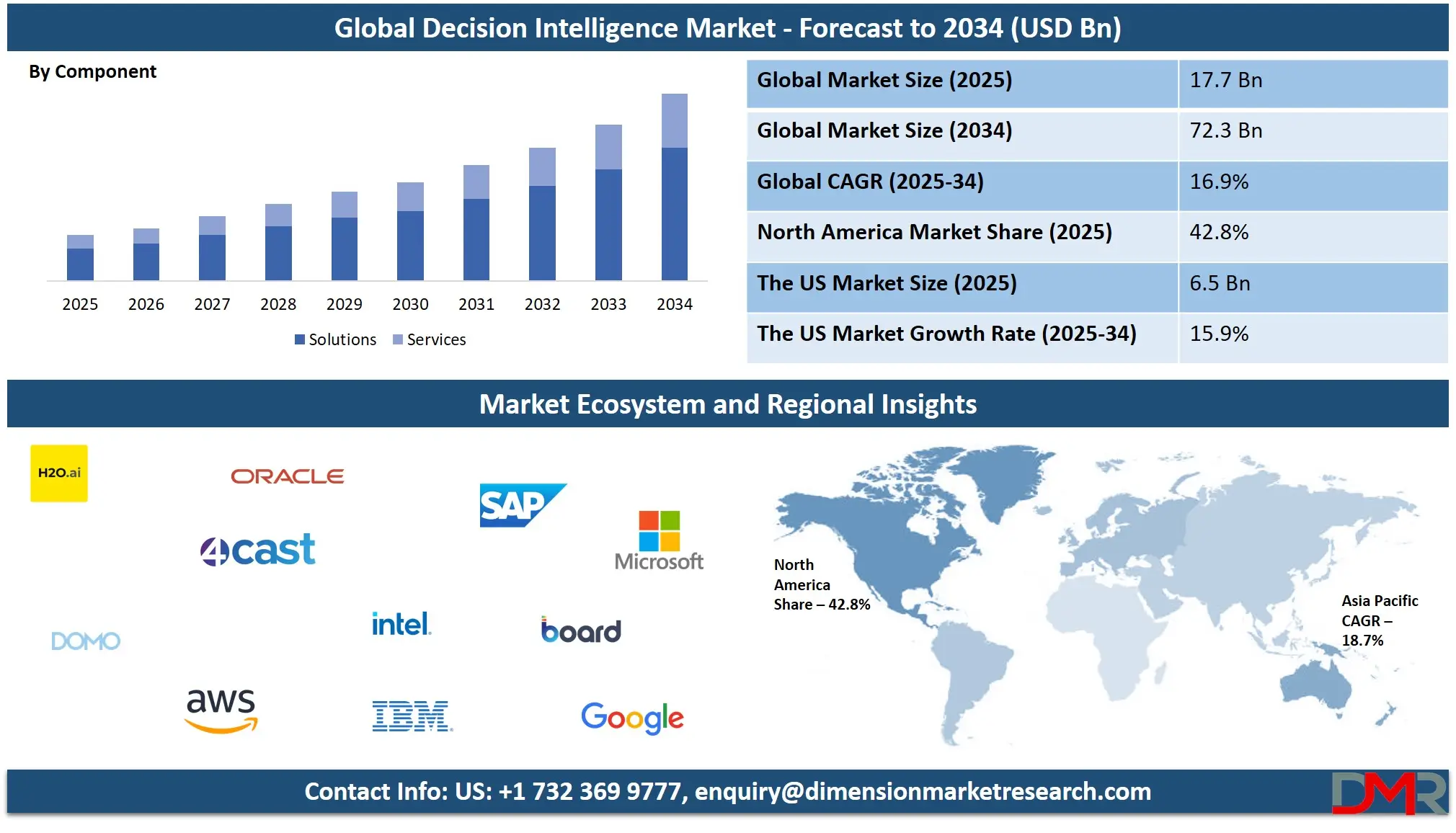
The demand for Decision Intelligence is growing as businesses face more complex choices and massive amounts of data. Traditional decision-making methods are often too slow or prone to bias. DI tools help solve these problems by offering clear suggestions or automating parts of the decision process. This is especially useful in industries like finance, healthcare, supply chain, and marketing, where real-time, data-backed decisions can make a big difference.
Recent years have seen strong interest and investment in DI technologies. Companies are embedding DI systems in customer service, fraud detection, risk management, and product design. One key trend is the use of AI-powered platforms that analyze customer behavior and suggest the best marketing actions. Another trend is the use of DI in logistics to reduce delivery delays or improve inventory planning. These systems help businesses become more adaptive and proactive instead of just reacting to problems after they occur.
A major development in Decision Intelligence is the integration of generative AI and natural language processing (NLP). These tools allow DI systems to understand and respond to human language, making it easier for employees without technical skills to benefit from advanced analytics. For example, a manager can ask the system a question in plain language, and it will provide insights, charts, or suggestions. This makes complex data easier to understand and apply.
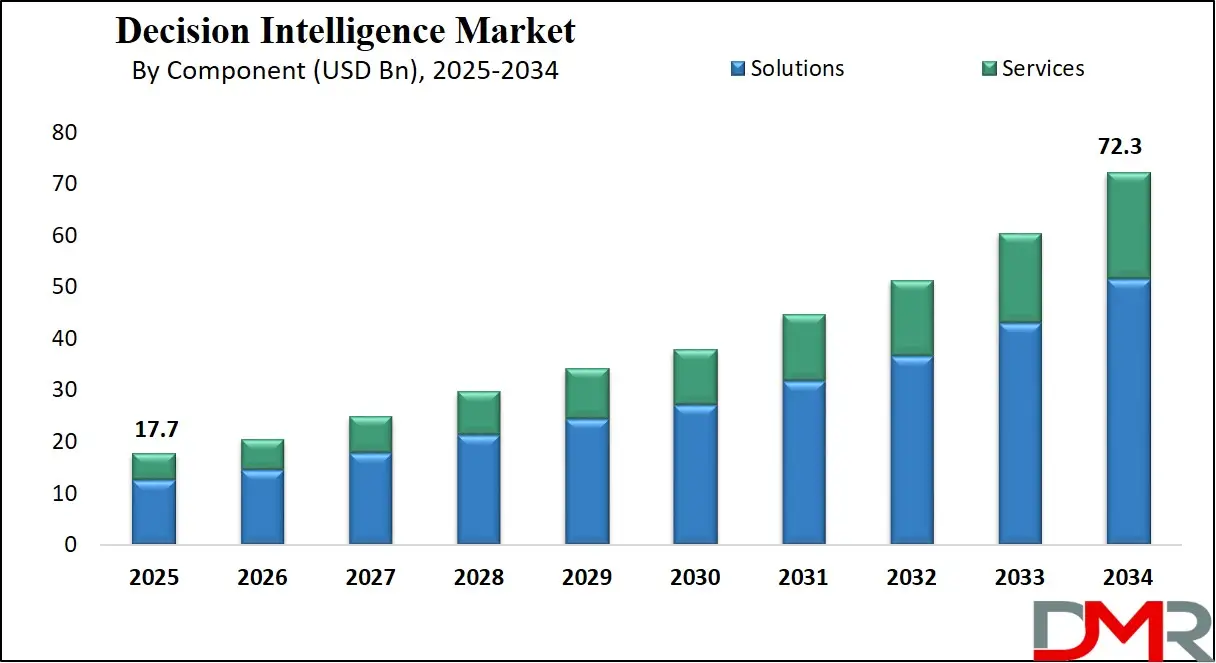
Another important trend is the rise of ethical and explainable AI in DI. Businesses now want their decision-making systems to be transparent, fair, and accountable. They need to know why a recommendation was made and ensure it's free from bias. This focus on responsible AI is pushing DI providers to design tools that can be trusted by both users and regulators.
The US Decision Intelligence Market
The US Decision Intelligence Market size is projected to reach USD 6.5 billion in 2025 at a compound annual growth rate of 15.9% over its forecast period.
The US plays a leading role in the Decision Intelligence market due to its advanced technology infrastructure, strong presence of AI and analytics companies, and high adoption across industries. US-based organizations are early adopters of DI tools in sectors like finance, healthcare, defense, and retail, driving innovation and shaping global trends. The country has a robust ecosystem of tech startups, research institutions, and cloud service providers that continuously develop new DI applications.
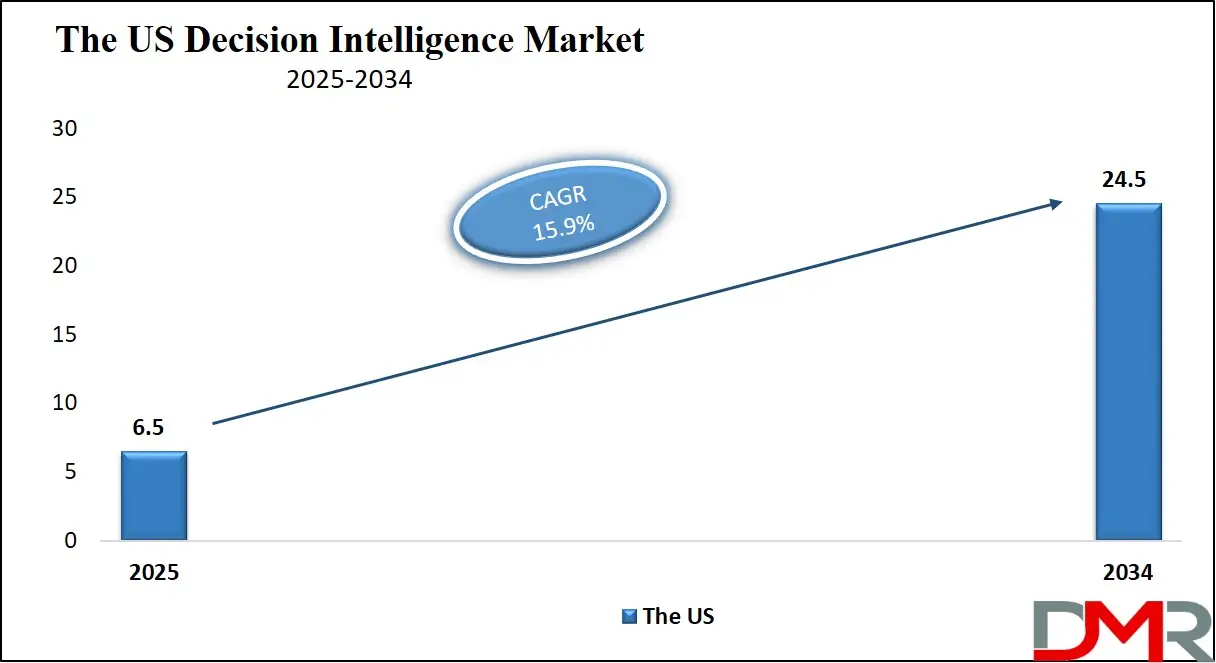
In addition, US businesses prioritize data-driven strategies to improve decision-making, performance, and competitiveness. Government agencies in the US are also exploring DI for public service improvements and national security. Overall, the US remains a key driver of research, investment, and commercial growth in the Decision Intelligence space.
Europe Decision Intelligence Market
Europe Decision Intelligence Market size is projected to reach USD 3.5 billion in 2025 at a compound annual growth rate of 16.2% over its forecast period.
Europe plays a major role in the growth of the Decision Intelligence market, driven by its strong focus on data privacy, ethical AI, and digital transformation. European countries are actively adopting DI solutions across sectors like manufacturing, logistics, healthcare, and public services to improve efficiency and strategic planning. The region is home to several research initiatives and policy frameworks that support responsible AI integration, which aligns well with the principles of Decision Intelligence.
Additionally, the rise of smart cities and Industry 4.0 projects across Europe is increasing the demand for intelligent decision-making systems. European companies value transparency and explainability, encouraging the development of DI tools that are both effective and compliant with regulations like the GDPR.
Japan Decision Intelligence Market
Japan Decision Intelligence Market size is projected to reach USD 1.1 billion in 2025 at a compound annual growth rate of 16.4% over its forecast period.
Japan plays an increasingly important role in the Decision Intelligence market, driven by its strong emphasis on automation, precision, and innovation. The country is adopting DI tools across sectors such as manufacturing, healthcare, finance, and transportation to enhance decision-making speed and accuracy. Japan’s national strategies promoting digital transformation and smart infrastructure support the integration of AI and analytics into business and government operations.
Companies in Japan use DI platforms to optimize production lines, manage supply chains, and improve customer service. Additionally, Japan's focus on robotics and predictive technologies aligns well with the goals of Decision Intelligence. With its culture of continuous improvement and technology leadership, Japan is helping to shape the advancement and responsible use of DI across Asia.
Decision Intelligence Market: Key Takeaways
- Market Growth: The Decision Intelligence Market size is expected to grow by USD 51.9 billion, at a CAGR of 16.9%, during the forecasted period of 2026 to 2034.
- By Component: The solution segment is anticipated to get the majority share of the Decision Intelligence Market in 2025.
- By Deployment: On-Premise segment is expected to get the largest revenue share in 2025 in the Decision Intelligence Market.
- Regional Insight: North America is expected to hold a 42.8% share of revenue in the Global Decision Intelligence Market in 2025.
- Use Cases: Some of the use cases of Decision Intelligence include supply chain management, healthcare treatment planning, and more.
Decision Intelligence Market: Use Cases
- Customer Experience Optimization: Decision Intelligence helps businesses understand customer behavior by analyzing data from various sources. It recommends personalized offers, improves service strategies, and predicts customer churn. This leads to better engagement and higher satisfaction.
- Supply Chain Management: DI tools monitor real-time logistics data and anticipate delays or risks in the supply chain. They help optimize inventory levels, shipping routes, and supplier decisions. This improves efficiency and reduces costs.
- Fraud Detection and Risk Management: By analyzing patterns and anomalies in transactions, Decision Intelligence identifies possible fraud or financial risks. It supports faster, more accurate decisions to prevent losses and maintain trust. Financial institutions and insurers benefit greatly from this.
- Healthcare Treatment Planning: DI systems assist doctors by evaluating patient data and predicting treatment outcomes. They support faster diagnosis and personalized care paths. This leads to better patient results and smarter resource use.
Market Dynamic
Driving Factors in the Decision Intelligence Market
Rising Need for Data-Driven Decision Making
One of the major growth drivers of the Decision Intelligence market is the increasing demand for data-backed decision-making across industries. As businesses generate large volumes of data from operations, customers, and digital platforms, the challenge lies in turning that data into actionable insights. Decision Intelligence tools offer a structured way to process complex data and guide better business decisions.
Organizations want to move beyond intuition or basic analytics and rely on systems that can simulate outcomes and provide smart suggestions. This need is especially urgent in fast-changing environments like finance, retail, logistics, and healthcare. The push to stay competitive, minimize errors, and increase efficiency makes DI an essential investment for modern enterprises. As a result, adoption is steadily rising.
Integration of Advanced Technologies like AI and NLP
The integration of artificial intelligence, machine learning, and natural language processing is significantly driving the growth of the Decision Intelligence market. These technologies enhance the ability of DI systems to understand data, make predictions, and communicate findings in an easy-to-use manner. With AI, DI platforms can continuously learn and improve over time, while NLP makes it possible for users to interact with systems using everyday language.
This lowers the entry barrier for non-technical users and encourages adoption across all departments, not just IT or data science teams. Businesses are eager to adopt tools that combine automation with human-like reasoning. This trend is opening up new applications and expanding DI into small and mid-sized businesses as well.
Restraints in the Decision Intelligence Market
High Implementation Complexity and Cost
One of the key restraints in the Decision Intelligence market is the complexity and cost of implementation. Setting up a DI system often requires significant changes to existing workflows, integration with multiple data sources, and alignment across departments. This process can be time-consuming and expensive, especially for small and medium-sized businesses with limited resources.
Additionally, skilled professionals are needed to manage the tools, interpret the results, and maintain the systems over time. Many organizations struggle with data quality, legacy systems, and unclear ownership of decision-making processes. These barriers can slow down or discourage adoption, especially in companies that are not yet digitally mature or lack strong IT infrastructure.
Data Privacy and Security Concerns
Another major restraint affecting the growth of the Decision Intelligence market is concern over data privacy and security. Since DI systems rely on collecting and processing vast amounts of sensitive data, there is always a risk of breaches, misuse, or non-compliance with data protection regulations.
Organizations in sectors like healthcare, finance, and government must be especially cautious when using automated systems for decision-making. Even a minor flaw in data governance can lead to serious consequences, including legal penalties and loss of customer trust. This concern makes some companies hesitant to fully adopt DI platforms. Ensuring secure, ethical, and compliant use of data remains a major challenge for the industry.
Opportunities in the Decision Intelligence Market
Expansion into Emerging Economies
An important opportunity for the Decision Intelligence market lies in its growing potential within emerging economies. As countries in Asia, Latin America, and Africa undergo digital transformation, businesses and governments are seeking smarter ways to manage operations and serve populations. These regions are investing in infrastructure, education, and technology, creating fertile ground for the adoption of DI tools.
Industries such as telecom, banking, healthcare, and e-commerce in these markets face complex decisions daily and stand to benefit significantly from intelligent systems. The relatively untapped nature of these regions offers vendors a chance to expand their reach. With increasing smartphone and internet penetration, more data is being generated, making these markets highly promising for future DI growth.
Rise of Low-Code and No-Code Platforms
The rise of low-code and no-code platforms presents a major opportunity for the Decision Intelligence market. These platforms allow users with little to no programming skills to build, customize, and deploy DI tools easily. This democratizes access to advanced analytics and decision-making capabilities, extending them beyond data scientists to everyday business users.
As a result, more departments like sales, HR, and marketing can make data-driven decisions without waiting for IT support. This shift increases the speed and scale of DI adoption within organizations. Vendors focusing on user-friendly interfaces and automation features are likely to attract a larger customer base. This trend supports greater innovation, flexibility, and adoption across industries and company sizes.
Trends in the Decision Intelligence Market
Convergence of Generative AI with Decision Models
A recent trend in the Decision Intelligence market is the merger of decision frameworks with generative AI. These advanced models now enhance DI systems by creating predictive simulations, drafting strategic reports, and summarizing complex datasets in natural language. Users can interact with systems conversationally, asking questions and receiving comprehensive insights as if speaking with an expert analyst.
This evolution simplifies the decision process and brings a collaborative, human-like interface to data tools. It also helps teams accelerate ideation, scenario planning, and value assessment without needing technical expertise. As generative AI evolves, it’s becoming a driving force in making decision tools more adaptive, creative, and universally accessible.
Focus on Explainability and Ethical Decisioning
Another growing trend is the emphasis on explainable and ethical decision-making within DI platforms. Companies are demanding that decision tools not only produce suggestions but also clearly explain how those outcomes were derived. This shift aims to build trust in automated systems, address bias, and comply with emerging regulations. As a result, platforms are incorporating transparent model visualizations, audit trails, and ethical frameworks. Decision workflows now often include fairness checks, risk assessments, and human oversight steps. This trend reflects a broader move towards responsible AI—ensuring that decisions are not only smart but also just, traceable, and aligned with moral and regulatory standards.
Impact of Artificial Intelligence in Decision Intelligence Market
Artificial Intelligence (AI) is playing an important role in shaping the growth and evolution of the Decision Intelligence market. By enabling machines to process, learn from, and analyze vast amounts of data, AI enhances how organizations make decisions across different levels. AI-powered algorithms help identify patterns, predict future outcomes, and simulate multiple scenarios, allowing businesses to make well-informed choices faster.
This is particularly useful in complex and dynamic environments where traditional decision-making methods fall short. With AI, Decision Intelligence systems can offer recommendations, automate routine decisions, and adapt continuously to changing conditions without constant human intervention. These capabilities make AI an essential engine behind more agile and intelligent business strategies.
Moreover, the integration of natural language processing, computer vision, and machine learning models into Decision Intelligence platforms is making these tools more accessible and effective. Users can now interact with systems in plain language, making it easier for non-technical teams to gain insights and take action. AI also supports real-time decision-making, enabling companies to respond quickly to risks or opportunities as they arise.
As AI technology continues to advance, its impact on Decision Intelligence will only grow, pushing the boundaries of what’s possible in areas like forecasting, optimization, and automation. This close relationship between AI and Decision Intelligence is driving digital transformation across industries and helping organizations become more proactive, responsive, and competitive in a data-driven world.
Research Scope and Analysis
By Component Analysis
Solution component is expected to take prominent position the Decision Intelligence market in 2025 with a share of 71.2%, playing a major role in shaping the overall growth of the industry. Solutions are being widely adopted by businesses to streamline decision-making processes, improve accuracy, and gain real-time insights from large volumes of data. These tools combine predictive analytics, machine learning, and data visualization to offer actionable recommendations.
Companies across industries prefer integrated Decision Intelligence solutions that are easy to implement and scale, supporting functions like customer analytics, risk management, and operational forecasting. With rising demand for automation and smart analytics, solutions are becoming a core part of enterprise digital strategies. As more businesses focus on optimizing workflows and enhancing business intelligence, the solution segment is expected to see continued growth and maintain its dominance in the market throughout the forecast period.
Service component, on the other hand, is showing significant growth over the forecast period as organizations look for expert support in deploying and managing Decision Intelligence platforms. The need for consulting, system integration, and ongoing maintenance is rising, especially among businesses that are new to advanced analytics. Services help bridge knowledge gaps, customize solutions, and ensure smooth operation of decision tools.
Managed and professional services are also enabling companies to focus on core operations while experts handle technical complexities. As more industries begin adopting Decision Intelligence, the demand for service providers with experience in training, support, and implementation is increasing steadily. This makes the service segment an important driver of market expansion, especially in developing regions and among mid-sized enterprises.
By Deployment Analysis
On-Premise deployment is expected to dominate the Decision Intelligence market in 2025 with a share of 67.6%, largely due to the high demand for data control, privacy, and customized infrastructure. Many large organizations, especially in sectors like banking, government, and healthcare, prefer on-premise systems because they offer tighter security and compliance with internal policies.
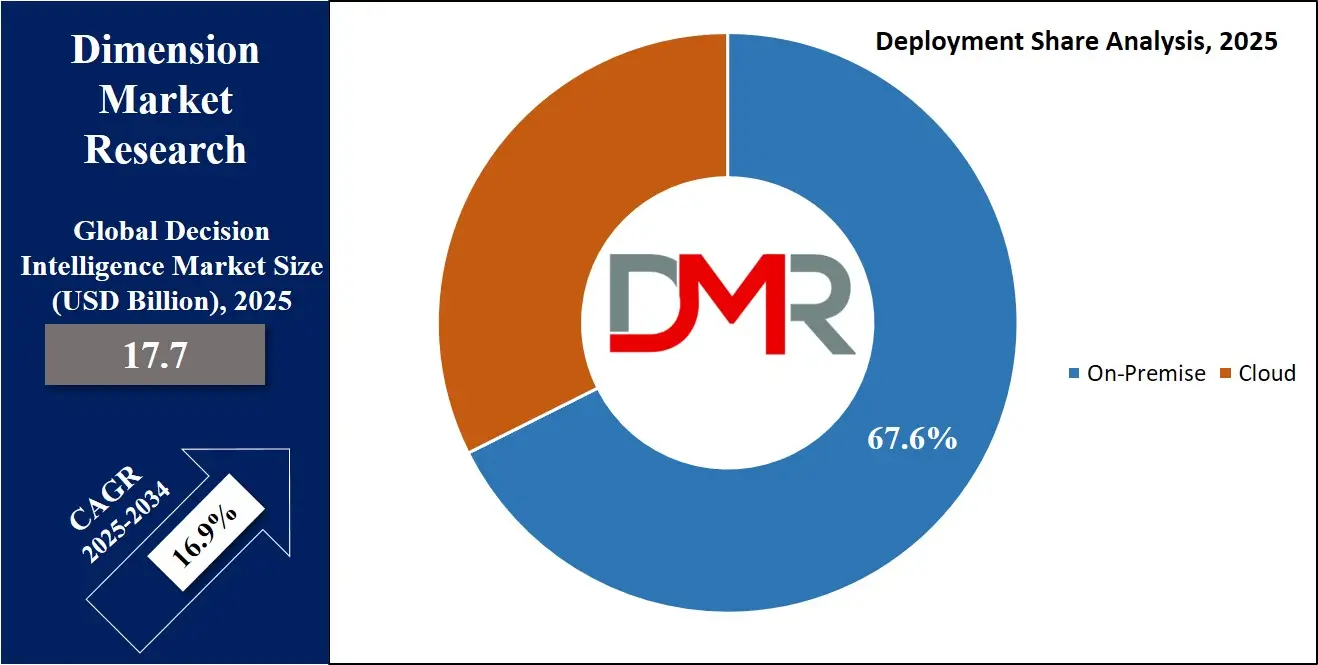
These setups allow full ownership of hardware and data, which is essential for businesses handling sensitive or confidential information. On-premise deployment also supports better system customization and integration with legacy systems. While cloud solutions are rising, many enterprises still rely on their existing IT infrastructure for complex decision-making tasks.
As businesses seek more secure, tailored, and stable environments, the on-premise model is expected to maintain strong traction, particularly among organizations with critical operations that require complete control over their data assets and workflows. Cloud deployment continues to gain momentum in the Decision Intelligence market, showing significant growth over the forecast period due to its flexibility, scalability, and cost-efficiency.
Businesses of all sizes, especially small and medium enterprises, are choosing cloud-based platforms to access real-time insights and deploy solutions without heavy infrastructure investments. The cloud enables faster updates, easy integration with external data sources, and remote accessibility, which supports agile decision-making.
With more companies adopting hybrid work models and global operations, cloud-based Decision Intelligence tools are helping teams collaborate and act on insights from anywhere. Service providers are also enhancing their offerings with advanced analytics and security features tailored for cloud users. This shift toward digital transformation and operational agility is driving the demand for cloud deployment across various industries.
By Enterprise Size Analysis
Large Enterprises are set to lead the Decision Intelligence market in 2025 with a share of 64.3%, driven by their strong focus on digital transformation and strategic decision-making. These organizations manage vast amounts of data and require advanced tools to turn that data into actionable insights. Decision Intelligence helps them automate processes, reduce risks, and make faster, data-backed choices.
With large budgets and established IT infrastructure, they can implement complex DI solutions that integrate across departments like finance, operations, and customer service. Industries such as banking, telecom, and healthcare are seeing high adoption among large enterprises due to their need for precision and scale. Their ability to invest in cutting-edge analytics and artificial intelligence platforms further boosts their use of Decision Intelligence. As global competition grows, large enterprises will continue to rely on intelligent systems to stay ahead and optimize long-term performance.
SMEs are seeing strong growth in the Decision Intelligence market over the forecast period as they look to gain a competitive edge through smarter, data-driven decisions. With the growing availability of affordable, cloud-based DI tools, small and medium enterprises are now able to adopt solutions that were once limited to larger corporations. These businesses are using DI platforms to improve customer engagement, streamline operations, and manage risks more effectively.
As SMEs face increasing pressure to operate efficiently and respond quickly to market changes, the flexibility and ease of use offered by modern Decision Intelligence solutions make them highly attractive. The trend toward digital adoption, especially in sectors like retail, logistics, and services, is also pushing more SMEs to invest in decision-support technologies to enhance business outcomes.
By End User Industry Analysis
Healthcare is expected to lead the Decision Intelligence market in 2025 with a share of 31.8%, as the industry increasingly depends on data to improve patient care and operational efficiency. Hospitals, clinics, and research institutions are using DI tools to support clinical decisions, forecast patient needs, and streamline resource management. By analyzing patient records, treatment outcomes, and operational workflows, healthcare providers can make faster and more accurate decisions.
These tools are also helping in areas like diagnosis support, hospital staffing, and preventive care planning. With the growing pressure to reduce costs while improving quality, Decision Intelligence offers healthcare organizations a powerful way to act on insights in real time. As the sector continues to digitize and adopt advanced analytics, DI is becoming essential for delivering better outcomes, reducing errors, and managing complex healthcare environments more effectively.
Retail & E-commerce is showing strong growth in the Decision Intelligence market over the forecast period, driven by the need for personalized customer experiences and efficient inventory management. Businesses in this space are using DI tools to track consumer behavior, forecast demand, and optimize pricing strategies. These systems help improve decision-making in marketing, logistics, and sales by turning customer data into meaningful insights.
With the rapid shift to online shopping and growing competition, companies are looking for ways to stay agile and responsive. Decision Intelligence enables faster reactions to market trends, supports real-time promotions, and enhances product recommendations. As retail continues to blend physical and digital experiences, the demand for intelligent decision-making tools is expected to grow steadily across small and large e-commerce players.
The Decision Intelligence Market Report is segmented on the basis of the following:
By Component
By Deployment
By Enterprise Size
By End User Industry
- Healthcare
- IT & Telecom
- BFSI
- Retail & E-commerce
- Manufacturing
- Government
- Others
Regional Analysis
Leading Region in the Decision Intelligence Market
North America will dominate the Decision Intelligence market in 2025 with a share of 42.8%, showing how strongly the region is driving the growth of this industry. The high adoption of advanced technologies, strong digital infrastructure, and presence of major tech companies are major reasons behind this leadership. Businesses across the region, especially in the United States and Canada, are using Decision Intelligence tools to improve operations, predict outcomes, and support faster, more accurate decision-making.
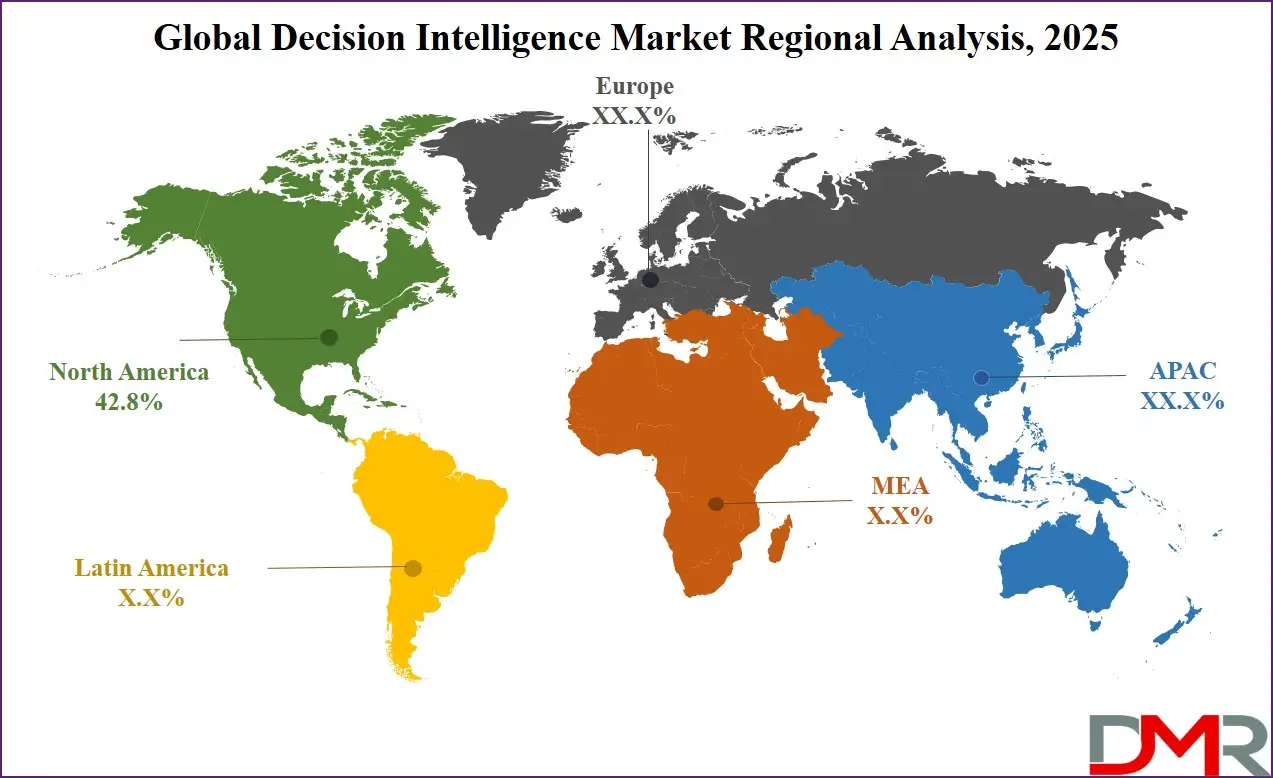
The growing use of cloud services, data analytics, and automation in sectors like finance, healthcare, manufacturing, and retail is helping expand the market further. In addition, a strong focus on innovation, combined with increasing investments in AI and analytics, is supporting the rise of intelligent decision platforms. As 2025 continues, it is expected that North America will maintain its strong position, fueled by both public and private initiatives aimed at digital transformation and smarter, data-driven business strategies.
Fastest Growing Region in the Decision Intelligence Market
Asia Pacific is showing significant growth in the Decision Intelligence market over the forecast period due to rapid digital transformation, rising investments in data-driven technologies, and growing awareness about the benefits of intelligent decision-making. Countries like China, India, Japan, and South Korea are actively adopting Decision Intelligence tools to enhance business performance, customer experience, and operational efficiency.
The expansion of cloud computing, machine learning, and automation in industries such as manufacturing, retail, and healthcare is also driving demand. With supportive government initiatives and a growing tech-savvy population, it is expected that Asia Pacific will emerge as one of the fastest-growing regions in the global Decision Intelligence landscape.
By Region
North America
Europe
- Germany
- The U.K.
- France
- Italy
- Russia
- Spain
- Benelux
- Nordic
- Rest of Europe
Asia-Pacific
- China
- Japan
- South Korea
- India
- ANZ
- ASEAN
- Rest of Asia-Pacific
Latin America
- Brazil
- Mexico
- Argentina
- Colombia
- Rest of Latin America
Middle East & Africa
- Saudi Arabia
- UAE
- South Africa
- Israel
- Egypt
- Rest of MEA
Competitive Landscape
The Decision Intelligence market is becoming highly competitive as more companies across industries realize the value of using data-driven tools to improve their choices. Technology providers are working to create smarter platforms that combine artificial intelligence, analytics, and user-friendly interfaces. The competition is focused on offering faster, more accurate, and easier-to-use solutions that help businesses make better decisions.
Some players specialize in areas like supply chain, finance, or customer experience, while others provide all-in-one platforms for multiple functions. There is also growing interest in adding features like natural language understanding and visual dashboards to make decision tools more accessible. Overall, the market is shaped by innovation, speed, ease of use, and the ability to adapt to different industries and needs.
Some of the prominent players in the global Decision Intelligence are:
- Google
- Microsoft
- IBM
- Oracle
- Intel
- SAP
- AWS (Amazon Web Services)
- Domo
- Board International
- Pyramid Analytics
- Provenir
- 4CAST
- H2O.ai
- Clarifai
- Diwo.ai
- Remi.AI
- Quantellia
- Peak.ai
- Metaphacts
- Other Key Players
Recent Developments
- In June 2025, MathCo announced the expansion of its partnership with Snowflake at the Snowflake Summit 2025. This collaboration aims to drive AI-led innovation and help clients unlock the full potential of their data on Snowflake through MathCo’s enterprise AI expertise. As part of the initiative, MathCo is launching a dedicated Center of Excellence (CoE) for Snowflake to support Fortune 500 and Global 2000 companies in scaling AI and ML efforts, delivering impactful solutions, and enhancing its Snowflake-certified talent base.
- In June 2025, project44, the architects of the modern supply chain, hosted its Velocity event at its Chicago headquarters in the iconic Merchandise Mart. During the event, the company unveiled the evolution of its Movement platform into a new category called Decision Intelligence. CEO Jett McCandless emphasized that while AI is widely discussed, businesses need practical tools that integrate with existing operations. The new platform is designed to reduce delays, enhance customer responsiveness, and drive cost savings—delivering tangible value through smarter, automated supply chain decisions.
- In June 2025, Bamboo Rose has officially rebranded Verteego under the name Decision Intelligence. This rebranding marks a significant step in fully integrating the French startup, which was acquired in January. The new identity reflects Bamboo Rose’s strategic vision to lead the decision intelligence space, applying advanced data-driven insights across the entire product lifecycle. With this move, the company reinforces its commitment to innovation and positions itself at the forefront of intelligent retail decision-making from concept to consumer.
- In May 2025, Aera Technology has introduced its new Tariff Mitigation Skill, a decision intelligence solution that unifies supply chain data, forecasts tariff impacts, adjusts plans in real-time, and automates decisions. This helps organizations minimize risk, safeguard margins, and remain agile in changing trade conditions.
Report Details
| Report Characteristics |
| Market Size (2025) |
USD 17.7 Bn |
| Forecast Value (2034) |
USD 72.3 Bn |
| CAGR (2025–2034) |
16.9% |
| Historical Data |
2019 – 2024 |
| The US Market Size (2025) |
USD 6.5 Bn |
| Forecast Data |
2025 – 2033 |
| Base Year |
2024 |
| Estimate Year |
2025 |
| Report Coverage |
Market Revenue Estimation, Market Dynamics, Competitive Landscape, Growth Factors, etc. |
| Segments Covered |
By Component (Solutions and Services), By Deployment (Cloud and On Premises), By Enterprise Size (SMEs and Large Enterprises), By End User Industry (Healthcare, IT & Telecom, BFSI, Retail & E-commerce, Manufacturing, Government, and Others) |
| Regional Coverage |
North America – US, Canada; Europe – Germany, UK, France, Russia, Spain, Italy, Benelux, Nordic, Rest of Europe; Asia-Pacific – China, Japan, South Korea, India, ANZ, ASEAN, Rest of APAC; Latin America – Brazil, Mexico, Argentina, Colombia, Rest of Latin America; Middle East & Africa – Saudi Arabia, UAE, South Africa, Turkey, Egypt, Israel, Rest of MEA |
| Prominent Players |
Google, Microsoft, IBM, Oracle, Intel, SAP, AWS (Amazon Web Services), Domo, Board International, Pyramid Analytics, Provenir, 4CAST, H2O.ai, Clarifai, Diwo.ai, Remi.AI, Quantellia, Peak.ai, Metaphacts, and Other Key Players |
| Purchase Options |
We have three licenses to opt for: Single User License (Limited to 1 user), Multi-User License (Up to 5 Users), and Corporate Use License (Unlimited User) along with free report customization equivalent to 0 analyst working days, 3 analysts working days, and 5 analysts working days respectively. |
Frequently Asked Questions
The Global Decision Intelligence Market size is expected to reach a value of USD 17.7 billion in 2025 and is expected to reach USD 72.3 billion by the end of 2034.
North America is expected to have the largest market share in the Global Decision Intelligence Market, with a share of about 42.8% in 2025.
The Decision Intelligence Market in the US is expected to reach USD 6.5 billion in 2025.
Some of the major key players in the Global Decision Intelligence Market are Google, Microsoft, IBM, and others
The market is growing at a CAGR of 16.9 percent over the forecasted period.